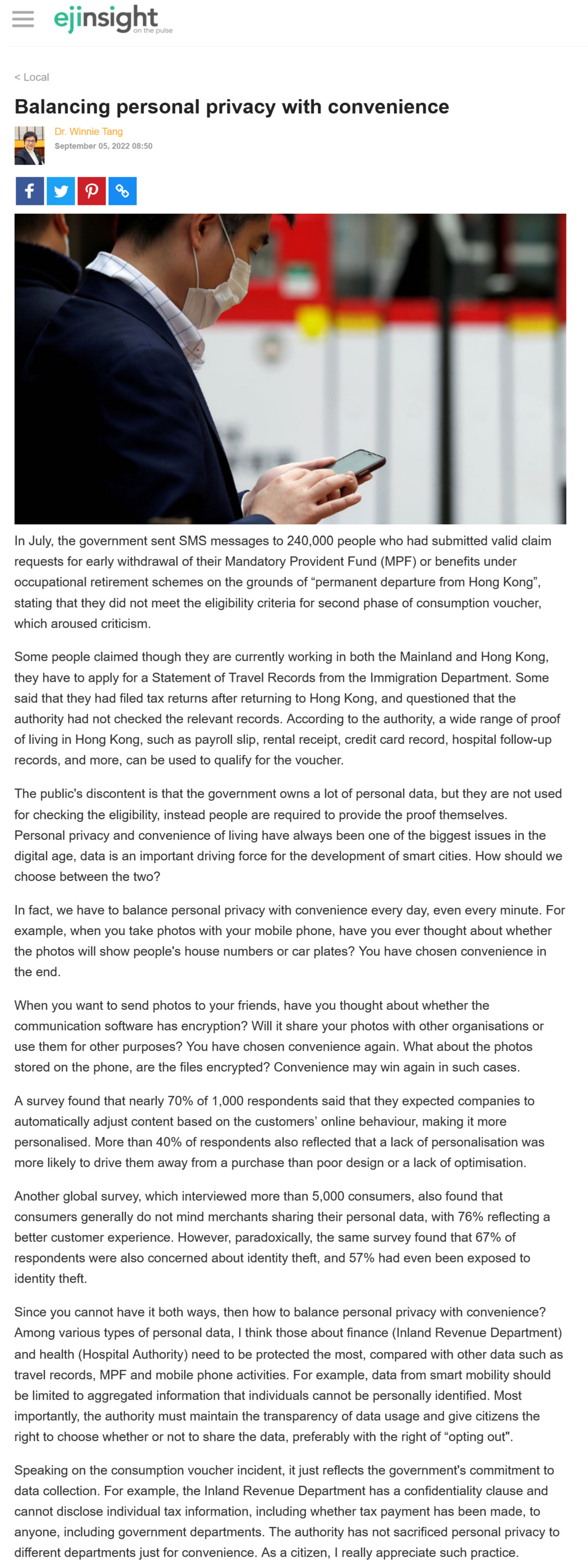網上版請按此

Balancing personal privacy with convenience
In July, the government sent SMS messages to 240,000 people who had submitted valid claim requests for early withdrawal of their Mandatory Provident Fund (MPF) or benefits under occupational retirement schemes on the grounds of "permanent departure from Hong Kong", stating that they did not meet the eligibility criteria for second phase of consumption voucher, which aroused criticism.
Some people claimed though they are currently working in both the Mainland and Hong Kong, they have to apply for a Statement of Travel Records from the Immigration Department. Some said that they had filed tax returns after returning to Hong Kong, and questioned that the authority had not checked the relevant records. According to the authority, a wide range of proof of living in Hong Kong, such as payroll slip, rental receipt, credit card record, hospital follow-up records, and more, can be used to qualify for the voucher.
The public's discontent is that the government owns a lot of personal data, but they are not used for checking the eligibility, instead people are required to provide the proof themselves. Personal privacy and convenience of living have always been one of the biggest issues in the digital age, data is an important driving force for the development of smart cities. How should we choose between the two?
In fact, we have to balance personal privacy with convenience every day, even every minute. For example, when you take photos with your mobile phone, have you ever thought about whether the photos will show people's house numbers or car plates? You have chosen convenience in the end.
When you want to send photos to your friends, have you thought about whether the communication software has encryption? Will it share your photos with other organisations or use them for other purposes? You have chosen convenience again. What about the photos stored on the phone, are the files encrypted? Convenience may win again in such cases.
A survey found that nearly 70% of 1,000 respondents said that they expected companies to automatically adjust content based on the customers' online behaviour, making it more personalised. More than 40% of respondents also reflected that a lack of personalisation was more likely to drive them away from a purchase than poor design or a lack of optimisation.
Another global survey, which interviewed more than 5,000 consumers, also found that consumers generally do not mind merchants sharing their personal data, with 76% reflecting a better customer experience. However, paradoxically, the same survey found that 67% of respondents were also concerned about identity theft, and 57% had even been exposed to identity theft.
Since you cannot have it both ways, then how to balance personal privacy with convenience? Among various types of personal data, I think those about finance (Inland Revenue Department) and health (Hospital Authority) need to be protected the most, compared with other data such as travel records, MPF and mobile phone activities. For example, data from smart mobility should be limited to aggregated information that individuals cannot be personally identified. Most importantly, the authority must maintain the transparency of data usage and give citizens the right to choose whether or not to share the data, preferably with the right of "opting out".
Speaking on the consumption voucher incident, it just reflects the government's commitment to data collection. For example, the Inland Revenue Department has a confidentiality clause and cannot disclose individual tax information, including whether tax payment has been made, to anyone, including government departments. The authority has not sacrificed personal privacy to different departments just for convenience. As a citizen, I really appreciate such practice.
Dr. Winnie Tang
Adjunct Professor, Department of Computer Science, Faculty of Engineering; Department of Geography, Faculty of Social Sciences; and Faculty of Architecture, The University of Hong Kong